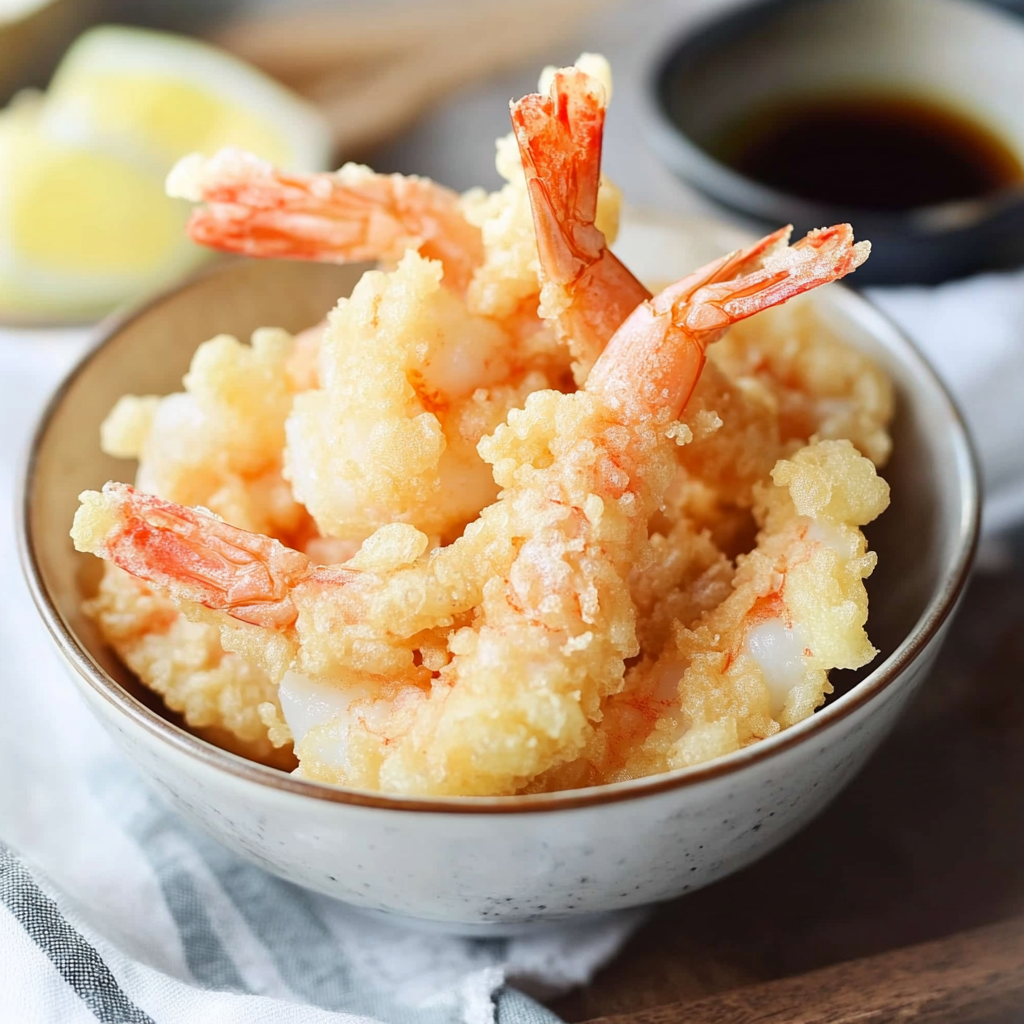The light, crisp batter of this Shrimp Tempura is a signature of Japanese culinary precision. Each shrimp is encased in a perfectly airy, golden coating that crackles at every bite, making it a delight for both your taste buds and your ears. Served with a traditional dipping sauce, it’s a simple yet elegant dish that instantly transports you to an izakaya in Tokyo.
Whether you’re making it as an appetizer or a main, Shrimp Tempura is a showstopper. Despite its sophisticated appearance, this dish is surprisingly easy and quick to make at home with just a few ingredients. It’s perfect for impressing guests or simply treating yourself to restaurant-style Japanese flavors in your own kitchen.
Full Recipe
Ingredients:
-
12 large raw shrimp, peeled and deveined (tails on)
-
1/2 cup all-purpose flour (plus extra for dusting)
-
1/4 cup cornstarch
-
1 egg (cold)
-
3/4 cup ice-cold water
-
Vegetable oil (for deep frying)
-
Optional: grated daikon, tempura dipping sauce (tentsuyu)
Directions:
-
Pat the shrimp dry using paper towels. Make small slits along the underside (belly side) of each shrimp to straighten them out. Gently press to flatten and lengthen.
-
Lightly dust the shrimp with flour to help the batter stick better.
-
In a bowl, combine the egg and ice-cold water. Whisk lightly.
-
Add flour and cornstarch into the bowl. Mix briefly with chopsticks—do not overmix; lumps are okay.
-
Heat vegetable oil in a deep pan to 340–350°F (170–180°C).
-
Dip each shrimp in the batter and carefully lower into the hot oil. Fry 2–3 shrimp at a time for about 2 minutes or until golden and crispy.
-
Remove with a slotted spoon and drain on paper towels.
-
Serve immediately with tempura dipping sauce and grated daikon if desired.
Prep Time: 15 minutes | Cooking Time: 10 minutes | Total Time: 25 minutes
Kcal: 230 kcal | Servings: 2 servings
Introduction to Shrimp Tempura
Shrimp Tempura is one of the most beloved and recognizable dishes in Japanese cuisine. Known for its delicate, crispy coating and succulent interior, this dish has made its way from traditional Japanese izakayas to fine dining restaurants and home kitchens around the world. Its appeal lies in its simplicity and elegance—lightly battered shrimp, fried until golden and crunchy, then served with a flavorful dipping sauce or alongside rice, noodles, or vegetables.
Originating during the Edo period in Japan, tempura was actually influenced by Portuguese missionaries and traders who introduced the concept of deep frying to Japanese cooks. Over centuries, the Japanese refined this technique into what we now recognize as tempura, with its ultra-light batter and expert frying method. Among the various ingredients used for tempura, shrimp remains the star—thanks to its natural sweetness, tender texture, and compatibility with the frying technique.
The Art of the Tempura Batter
The hallmark of great Shrimp Tempura lies in its batter. Unlike other fried foods, tempura batter should be whisper-light, almost ethereal in its texture. It is typically made with ice-cold water, a light hand in mixing, and a combination of flour and starch. The goal is not a heavy, bready crust but rather a lacy, crisp shell that enhances the shrimp’s flavor rather than overpowering it.
The batter is intentionally mixed just enough to combine the ingredients, leaving behind small lumps and air pockets. These inconsistencies contribute to the signature crispness during frying. The cold temperature of the batter is also key—it helps prevent the flour from absorbing too much oil and ensures a delicate crunch once fried.
Choosing the Right Shrimp
The type and quality of shrimp you use make a big difference in the final dish. Medium to large shrimp are ideal for tempura because they offer the best balance of texture and flavor. Shrimp should be peeled and deveined, with the tail left on for aesthetic appeal and ease of handling.
Straightening the shrimp before battering is a common professional trick that ensures a more elegant presentation. This is achieved by making small slits along the underside of each shrimp to break the muscle and then gently pressing them to straighten. This small step creates that classic elongated tempura shrimp shape you often see in Japanese restaurants.
Oil Temperature and Frying Technique
Deep-frying tempura is more art than science, though a good thermometer certainly helps. The oil should be maintained at a steady 340°F to 350°F (170°C to 180°C). Too hot, and the batter will brown before the shrimp cooks through. Too cold, and the shrimp will absorb excess oil, becoming soggy instead of crisp.
Shrimp Tempura is typically fried in small batches to avoid overcrowding, which can cause the oil temperature to drop. A few minutes in the hot oil is all it takes—about 1.5 to 2 minutes per shrimp. The result should be a golden, puffed-up coating that shatters delicately with each bite.
The Role of Dipping Sauce (Tentsuyu)
While Shrimp Tempura is excellent on its own, it’s often accompanied by a traditional dipping sauce called tentsuyu. This sauce is made from dashi (a Japanese broth), soy sauce, and mirin (a type of sweet rice wine), sometimes with a touch of sugar. It adds umami, saltiness, and depth to the otherwise mild and crisp shrimp.
Many enjoy adding grated daikon radish to the sauce, which brings a refreshing counterpoint to the richness of the fried shrimp. Tentsuyu can be served warm or at room temperature, and the shrimp are either dipped directly or lightly brushed with the sauce just before eating.
Serving Suggestions and Pairings
Shrimp Tempura is versatile and can be served in many ways. As a standalone appetizer, it’s elegant and satisfying. When paired with steamed white rice, it becomes a comforting main dish. It can also be served atop soba or udon noodles for a more filling meal, often referred to as “Tempura Soba” or “Tempura Udon.”
Tempura is commonly part of a mixed platter that includes vegetables such as sweet potatoes, eggplant, bell peppers, and green beans, all prepared using the same batter and frying method. This offers a colorful, flavorful assortment that highlights the tempura technique.
For a full Japanese meal experience, consider serving Shrimp Tempura alongside miso soup, a fresh cucumber sunomono salad, and pickled vegetables. A hot cup of green tea or cold sake also pairs beautifully with the dish.
Why Homemade Tempura Is Worth the Effort
Although Shrimp Tempura may look like something best left to restaurant chefs, it’s surprisingly easy to make at home with a few key tips. The satisfaction of preparing this dish yourself—tailoring the batter and cooking times to your preference—makes it well worth trying in your own kitchen.
Homemade tempura also means you can use fresher ingredients and better-quality oil. Plus, there’s something truly enjoyable about watching each piece puff up and crisp in the pan, then serving it immediately while it’s still piping hot and shatteringly crisp.
You also avoid preservatives or artificial ingredients often used in pre-made or frozen versions. In less than 30 minutes, you can produce a dish that rivals your favorite Japanese restaurant, tailored exactly to your taste.
Shrimp Tempura Around the World
Though firmly rooted in Japanese cuisine, Shrimp Tempura has become a global favorite. It’s found its way into modern fusion cuisine, appearing in sushi rolls (like tempura rolls), rice bowls, or even tacos and sliders.
In North America and Europe, it’s a common appetizer on Japanese restaurant menus. In Hawaii, tempura is part of local plate lunches. Meanwhile, chefs in fine-dining establishments continue to innovate by pairing shrimp tempura with creative sauces and sides.
Its global popularity speaks to the universal appeal of something that is crispy, savory, and deeply satisfying.
Nutritional Considerations
Shrimp Tempura, while indulgent, doesn’t have to be unhealthy if prepared properly. Shrimp is naturally low in calories and high in protein, as well as rich in selenium and vitamin B12. When fried in a clean, high-smoke point oil and drained well, the dish doesn’t retain as much grease as many might think.
For a lighter option, pair tempura with lots of fresh vegetables and consider air-frying or using a shallow pan-fry technique. You can also serve it with a vinegar-based salad or pickled vegetables to help balance the richness.
Conclusion
Shrimp Tempura is a celebration of texture, technique, and taste. With its roots in centuries-old Japanese culinary tradition, it continues to delight food lovers across cultures. Light yet flavorful, simple yet refined, this dish is a perfect example of how thoughtful preparation and quality ingredients can create a truly memorable eating experience.
Making Shrimp Tempura at home allows you to appreciate its subtle complexities—from achieving that perfect batter to mastering the frying technique. Whether you’re preparing it for a special occasion or a casual dinner, it’s bound to impress with its golden color, satisfying crunch, and delicate flavor.
So next time you’re craving something crispy and comforting, skip the takeout and try making Shrimp Tempura from scratch. It may just become your favorite Japanese dish to cook and share.






